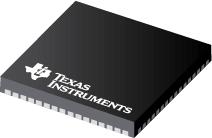●The TI MSP430 family of ultra-low-power microcontrollers consists of several devices featuring different sets of peripherals targeted for various applications. The architecture, combined with extensive low-power modes, is optimized to achieve extended battery life in portable measurement applications. The device features a powerful 16-bit RISC CPU, 16-bit registers, and constant generators that contribute to maximum code efficiency. The digitally controlled oscillator (DCO) allows the device to wake up from low-power modes to active mode in 3.5 µs (typical).
●The MSP430F522x series are microcontrollers with four 16-bit timers, a high-performance 10-bit ADC, two universal serial communication interfaces (USCIs), a hardware multiplier, DMA, a comparator, and an RTC module with alarm capabilities.
●The MSP430F521x series include all of the peripherals of the MSP430F522x series with the exception of the ADC.
●All devices have a split I/O supply system that allows for a seamless interface to other devices that have a nominal 1.8-V I/O interface without the need for external level translation.
●Typical applications include analog and digital sensor systems, data loggers, and various general-purpose applications.
● Dual-Supply Voltage Device
● Primary Supply (AVCC, DVCC):
● Powered From External Supply: 3.6 V Down to 1.8 V
● Up to 22 General-Purpose I/Os With up to Four External Interrupts
● Low-Voltage Interface Supply (DVIO):
● Powered From Separate External Supply: 1.62 V to 1.98 V
● Up to 31 General-Purpose I/Os With up to 12 External Interrupts
● Serial Communications
● Ultra-Low Power Consumption
● Active Mode (AM):
●All System Clocks Active
●290 µA/MHz at 8 MHz, 3.0 V, Flash Program Execution (Typical)
●150 µA/MHz at 8 MHz, 3.0 V, RAM Program Execution (Typical)
● Standby Mode (LPM3):
●Real-Time Clock (RTC) With Crystal, Watchdog, and Supply Supervisor Operational, Full RAM Retention, Fast Wakeup:
●1.9 µA at 2.2 V, 2.1 µA at 3.0 V (Typical)
●Low-Power Oscillator (VLO), General-Purpose Counter, Watchdog, and Supply Supervisor Operational, Full RAM Retention, Fast Wakeup:
●1.4 µA at 3.0 V (Typical)
● Off Mode (LPM4):
●Full RAM Retention, Supply Supervisor Operational, Fast Wakeup:
●1.1 µA at 3.0 V (Typical)
● Shutdown Mode (LPM4.5):
●0.18 µA at 3.0 V (Typical)
● Wake up From Standby Mode in 3.5 µs (Typical)
● 16-Bit RISC Architecture, Extended Memory, up to 25-MHz System Clock
● Flexible Power-Management System
● Fully Integrated LDO With Programmable Regulated Core Supply Voltage
● Supply Voltage Supervision, Monitoring, and Brownout
● Unified Clock System
● FLL Control Loop for Frequency Stabilization
● Low-Power Low-Frequency Internal Clock Source (VLO)
● Low-Frequency Trimmed Internal Reference Source (REFO)
● 32-kHz Watch Crystals (XT1)
● High-Frequency Crystals up to 32 MHz (XT2)
● 16-Bit Timer TA0, Timer_A With Five Capture/Compare Registers
● 16-Bit Timer TA1, Timer_A With Three Capture/Compare Registers
● 16-Bit Timer TA2, Timer_A With Three Capture/Compare Registers
● 16-Bit Timer TB0, Timer_B With Seven Capture/Compare Shadow Registers
● Two Universal Serial Communication Interfaces
● USCI_A0 and USCI_A1 Each Support:
● Enhanced UART With Automatic Baud Rate Detection
● IrDA Encoder and Decoder
● Synchronous SPI
● USCI_B0 and USCI_B1 Each Support:
● I2C
● Synchronous SPI
● 10-Bit Analog-to-Digital Converter (ADC) With Internal Reference, Sample-and-Hold
● Comparator
● Hardware Multiplier Supports 32-Bit Operations
● Serial Onboard Programming, No External Programming Voltage Needed
● Three-Channel Internal DMA
● Basic Timer With RTC Feature



